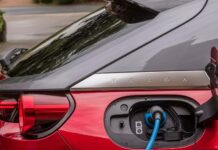[ad_1]
Toyota announced, by the way of a broader conference about batteries and electrification, that its new electric cars will have significantly more durable batteries.
The target set for the upcoming Toyota bZ4X and following BEVs is 90% of initial battery capacity (and range) maintained over 10 years of usage.
In other words, a car that has 500 km (311 miles) of range when new, should still have 450 km (280 miles) of range after 10 years. Of course, we assume that it could be less if the user would exceed the typical mileage or fast charging usage (Toyota does not reveal info about that).
Anyway, the target is very good and consistent with Toyota’s focus on the reliability of cars.
The currently available Toyota BEVs in China (C-HR and IZOA) had a target of about 75-80%, while the plug-in hybrid Priuses appear to be at about 50-55% (the first generation) and at about 60-65% (the second generation). At least that is what we see on the chart.
“We have applied the technologies that we have cultivated through the development of batteries for HEVs to PHEVs, and the batteries in the C-HR BEV have a greatly higher capacity retention rate after 10 years than the batteries hitherto used in our PHEVs.
Furthermore, for the Toyota bZ4X, which is scheduled to be launched soon, we have set a target of 90 percent endurance performance, which is one of the highest in the world, and we are currently finalizing our development efforts to achieve it.”

We don’t know exactly how Toyota intends to achieve its target as there are various ways. Starting with durable battery chemistry, through actively managing temperatures to keep the cells very close to their optimum range, limiting its performance (like fast charging) or simply adding some additional buffer that will mask the degradation a bit.
What we know is that the Japanese manufacturer is working hard on deep details, like the described below battery temperature monitoring systems of each individual cell:
“It is known that each battery cell shows signs of localized abnormal heat generation during spirited driving or other driving that places a large load on the battery.
By analyzing the phenomena occurring inside the battery and conducting a vast amount of model experiments, we have been able to clarify the effect of driving style on the battery, as well as the mechanism of this effect.
Based on the results, we have been able to detect signs of abnormal local heating of cells through multiple monitoring of voltage, current, and temperature of individual cells, blocks of cells, and the entire battery pack.
The battery is then controlled to prevent abnormal heat generation.
We will maintain our concept of ensuring safety, security, and reliability down to the local areas of each battery even when it comes to BEV systems, and we will continue to refine that concept.”

Another thing is that Toyota intends to focus on the quality of the battery cells to prevent defects:
“The third example I would like to share with you has to do with our efforts for achieving high-level quality.
If metallic foreign matter enters the battery during the manufacturing process and directly connects the anode and cathode electrically, there is the possibility of failure.
We confirmed the shape, material, and size of foreign matter that enters the manufacturing process and its effect on endurance, and we clarified how such affects batteries.
Based on this, we are being extremely attentive to the size and shape of foreign matter, and we are managing processes in a way that is aimed at preventing the generation or entry of relevant foreign matter.”

[ad_2]
Source link














